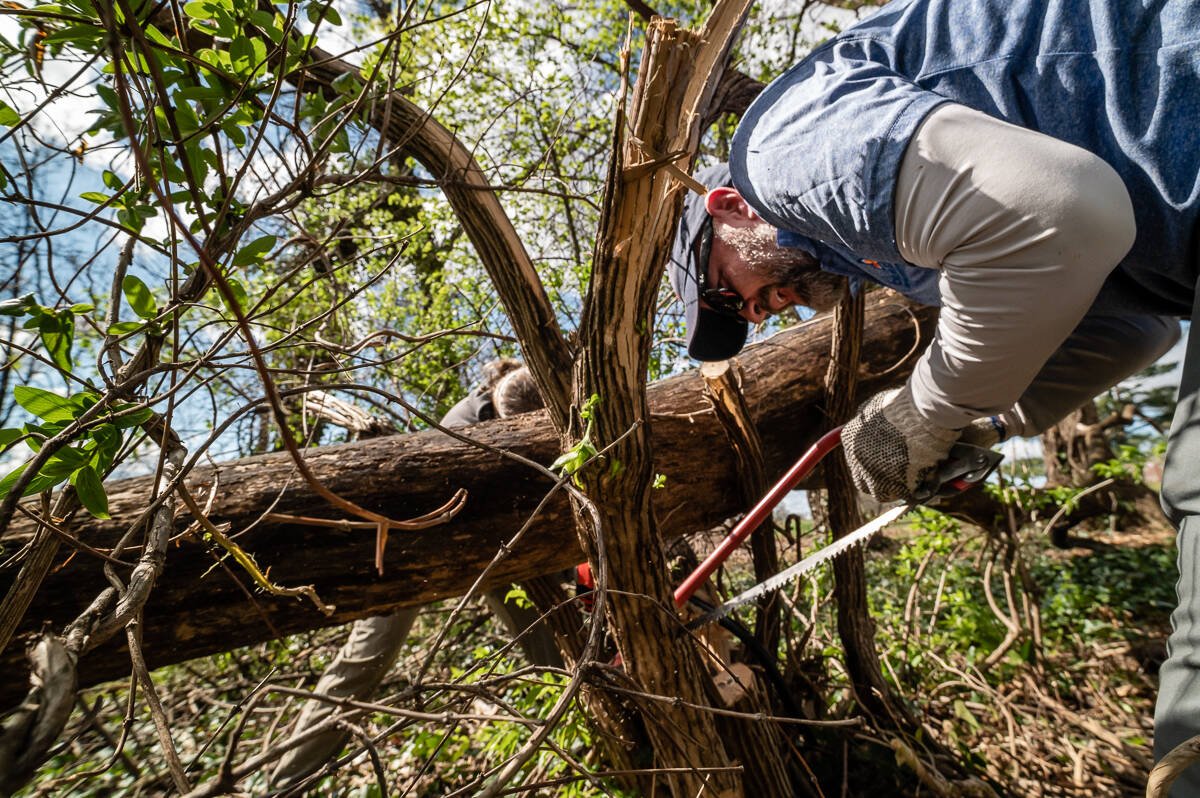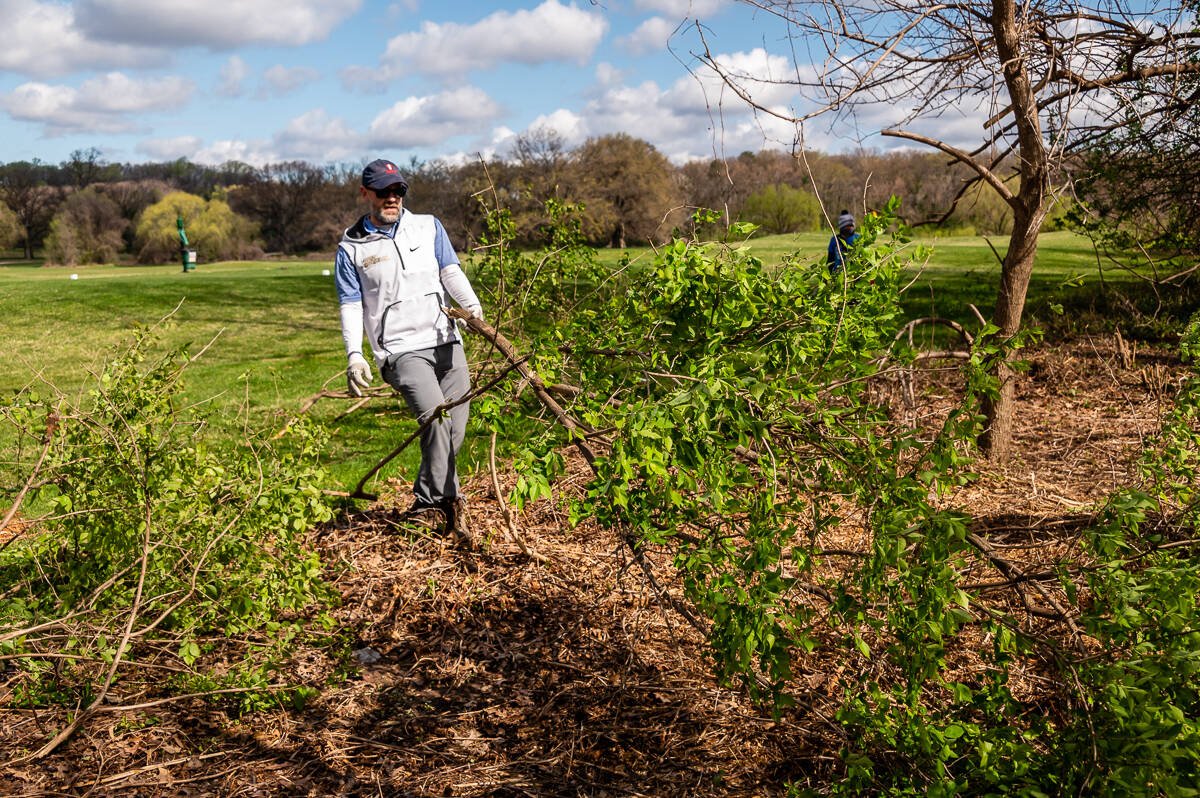Invasive Vegetation Management - A Langston Golf Course Update
Conquering the unmanaged invasive vegetation that lines the border of Langston Golf Course in Washington, D.C. is one of the biggest challenges in my new role as a sustainability consultant for the National Links Trust (NLT). There’s been a lot of learning on the job for me and figuring out how to tame the unruly beasts roaming the edges of this historic municipal golf course is one reason why. But thanks to the help of some local experts and the blood (at least my own) and sweat of many volunteers, we are starting to make some headway in vanquishing the vegetative invaders.
Here an example of how invasive vines can damage native trees.
The Anacostia Watershed Society (AWS) is the community partner leading the way through this intensive process. Jorge Bogantes Montero, a Natural Resource Specialist for AWS, is my primary contact and much of my work is really just listening and learning from his expertise in reforestation, wetland and meadow restoration and invasive vegetation management.
In all, we estimate a total of 35 acres of invasive vegetation along the edges of Langston Golf Course. The maps below can provide greater context if 35 acres doesn’t seem like much. Together with the help of Drew Matera, NLT Director of Agronomy, we are implementing a four step invasive vegetation management plan:
Vegetation and Tree Survey
Invasive Vegetation Removal
Pesticide Application
Revegetation
Vegetation and Tree Surveys
Jorge and I on the job at Langston performing a tree survey in early March, 2022
The first step in mitigating invasive vegetation is knowing the difference between your friends and your enemies. To do this, Jorge conducts vegetation and tree surveys with the help of a few volunteers (including myself). We mostly walk, trudge and climb through 1-2 acre plots full of vegetation that makes one feel like they’ve been transported to the thickest parts of the Amazon jungle. The goal of a vegetation and tree survey is to identify all tree species (with Jorge’s knowledge and the help of the iNaturalist app), plot locations of trees measuring over 30 inches in circumference and estimate total tree canopy coverage for the survey plot. We can usually cover a 2 acre plot in roughly 3 hours but that all depends on the thickness of the vegetation, the ground saturation and the number of trees.
Gathering the species and numbers of native, non-native and invasive trees is vital to my role as a sustainability consultant because we want to record as much data as we can on the types of species that call Langston home. This will allow us to better plan for the future with any reforestation projects and to gain historical perspective of the life of this ecosystem. For reference, here is how native, non-native and invasive are defined.
Native trees and vegetation originate from a specific location and should make up the vast majority of local ecosystems. Native trees to Langston include: black cherries, box elders, cottonwoods, apple varieties, redbuds, dogwoods, elms, pin oaks, red and silver maples, willows, willow oaks and my new favorite, sycamores.
Non-native trees and vegetation are species that originate from somewhere else and have adapted to living in a new environment. Despite being non-native, these species are seen as not harmful to the ecosystem. Non-native trees at Langston include black and honey locusts and catalpas.
Invasive trees and vegetation are species that outcompete native and non-native trees to the detriment of the surrounding ecosystems. These are often vines and thick, quick growing trees and bushes that choke, smother and kill surrounding trees. Invasive species we find the most at Langston are the bush honeysuckle, Japanese honeysuckle, english ivy, callery pears (they smell terrible), tree of heaven, hackberries, and white mulberries.
To date, I estimate that we have surveyed roughly 15 acres of vegetation at Langston.
This is what it looks like to stand in the middle of a bush honeysuckle forest. If these weren’t here, I would be able to see down the length of Langston’s 10th fairway.
This map provides visual reference for total area of invasive vegetation at Langston Golf Course, which is the yellow and turquoise area combined.
Invasive Vegetation Removal
Once we’ve completed a vegetation and tree survey, that specific area is now ready for phase 2, or what I like to call ‘stress relieving phase’. Invasive removal is exhausting and requires lots of manpower and time. We utilize a multi-faceted approach to accomplish this. First, several of Drew Matera’s staff spend dedicated time during their normal work hours using chainsaws and machetes to hack out the invasives and a small wood chipper to dispose of removed vegetation.
The second option is through hiring professional tree crews to come in and do the work but this can be very expensive. Our last paid job totaled about $17,000 for a six person crew to remove about 4 acres of invasive vegetation over the span of six days. Their heavy machinery allowed them to make an immediate impact but with roughly 27 more acres to remove, the bill can add up pretty quickly. We are also working with our new community partner, Casey Trees who has supplied us with a few two-three person crews that can take down about ½ acre of invasive vegetation in 8 hours.
The last option we employ is driven through our partnership with AWS. AWS organizes groups of 10-30 volunteers to spend 2-3 hours on the golf course removing invasive vegetation with hand saws, machetes and large garden clippers. A dedicated group of 20 volunteers can remove about a half to three quarters of an acre of invasive vegetation in about 3 hours. This is the subcategory I fall under and when I mentioned this activity as ‘stress relieving’ time, I wasn’t joking. There are not many activities that are more satisfying than taking a machete to a giant bush honeysuckle and saving a beautiful sycamore from a slow and painful death.
An additional option that we are not planning to use at Langston but has been successfully employed at other national parks and golf courses is goats. Goats will eat literally anything and a herd of 20-30 goats can chew down about an acre of vegetation in a day. This is the most sustainable, eco-friendly route but the landscape of Langston doesn’t make this an option we will pursue. The use of goats has proven to be a highly effective short term invasive vegetation removal tactic because it is cost-effective and the goat’s digestive system makes invasive seeds useless when evacuated.
To date, I estimate that we have removed roughly 7-8 acres of invasive vegetation.
We have a long way to go to the removing all the invasive vegetation!
Below are two actions shots of me (courtesy of conservation photographer, Bill MacFarland) sawing and removing bush honeysuckle. Below that is what a fully grown bush honeysuckle looks like when left to its own devices. The golf cart provides reference for how big these suckers can get.



Pesticide Application
The third step in this process is applying pesticides to the invasive vegetation stumps to prevent regrowth. We will either perform this in-house through Drew’s staff or through a third-party that can cover a larger area in less time. One way to limit the amount of chemicals we use is to employ wood chippers that can spray the chips as ground cover inhibiting invasive vegetation regrowth and creating circular methods for waste reuse.
Pesticide application will begin very soon as it is imperative we move quickly so as not to undue any of the hard work performed in removing the invasive vegetation.
Revegetation
The final step is the revegetation of the areas where the invasive vegetation was removed. There are two ways to go here. The most effective route is to purchase seed mixtures that fit with the specific environment like native transition seeds for upland or wetland areas. This tactic can be expensive, especially if you have 35 acres of land to regrow. The second route we can go is through the help of mother nature. We’ve identified several species of native vegetation on property that are easy to propagate and effective at providing ground cover in bare areas where invasive vegetation is removed. These include dogwoods, willow trees and swamp rose mallows.
Long-Term Benefits of Invasive Removal
Several months into this long process we are starting to see the fruits of our hard work as there are many added benefits to ridding Langston of the invasive vegetation forcefield that lines the golf course.
Removing invasive vegetation allows the golf course to breathe. Air movement is vital to grass health, especially in the summertime when temperatures can stay above 80 throughout the night.
Golfers gain views of the Anacostia River and Kingman Island that haven’t been seen for decades. Oftentimes when playing the back nine at Langston, it is easy to forget holes 10-13 are on an island.
The enhancement of the ecosystem. Local and migratory birds rarely use the canopy provided by invasive vegetation and trees so their removal allows native trees to provide more canopy and food supply for our feathered friends. We are also seeing the return of beavers and otters to the area.
Reclaiming lost contours of the golf course. Roughly 20-30 yards of the left side of 10th hole at Langston was lost due to invasive vegetation creeping into the fairway. It is now possible to see the rolling contours of the original design of the golf hole.
This before and after image shows the dramatic improvement to the ecosystem once the invasive vegetation was removed along the left side of the 10th hole at Langston. The top photo was taken in November, 2021 during my first vegetation survey with AWS. The bottom photo is what the same area looks like after a hired tree crew came through with heavy equipment to mitigate the thick undergrowth in early March, 2022.






